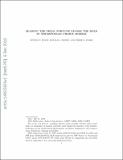Leading the field: Fortune favors the bold in Thurstonian choice models
Author(s)
Evans, Steven N.; Rivest, Ronald L; Stark, Philip B.
DownloadSubmitted version (263.5Kb)
Terms of use
Metadata
Show full item recordAbstract
Schools with the highest average student performance are often the smallest schools; localities with the highest rates of some cancers are frequently small; and the effects observed in clinical trials are likely to be largest for the smallest numbers of subjects. Informal explanations of this “small-schools phenomenon” point to the fact that the sample means of smaller samples have higher variances. But this cannot be a complete explanation: If we draw two samples from a diffuse distribution that is symmetric about some point, then the chance that the smaller sample has larger mean is 50%. A particular consequence of results proved below is that if one draws three or more samples of different sizes from the same normal distribution, then the sample mean of the smallest sample is most likely to be highest, the sample mean of the second smallest sample is second most likely to be highest, and so on; this is true even though for any pair of samples, each one of the pair is equally likely to have the larger sample mean. The same effect explains why heteroscedasticity can result in misleadingly small nominal p-values in nonparametric tests of association. Our conclusions are relevant to certain stochastic choice models, including the following generalization of Thurstone’s Law of Comparative Judgment. There are n items. Item i is preferred to item j if Z i < Z j , where Z is a random n-vector of preference scores. Suppose P{Z i = Z j } = 0 for i = j, so there are no ties. Item k is the favorite if Z k < min i = k Z i . Let p i denote the chance that item i is the favorite. We characterize a large class of distributions for Z for which p 1 > p 2 > · · · > pn. Our results are most surprising when P{Z i < Z j } = P{Z i > Z j } = 12 for i = j, so neither of any two items is likely to be preferred over the other in a pairwise comparison. Then, under suitable assumptions, p 1 > p 2 > · · · > p n when the variability of Z i decreases with i in an appropriate sense. Our conclusions echo the proverb “Fortune favors the bold”.
Date issued
2019-02Department
Massachusetts Institute of Technology. Department of Electrical Engineering and Computer ScienceJournal
Bernoulli
Publisher
Bernoulli Society for Mathematical Statistics and Probability
Citation
Evans, Steven N. et al. "Leading the field: Fortune favors the bold in Thurstonian choice models." Bernoulli 25, 1 (February 2019): 26-46. © 2019 ISI/BS
Version: Author's final manuscript
ISSN
1350-7265